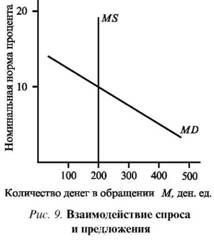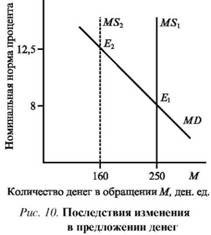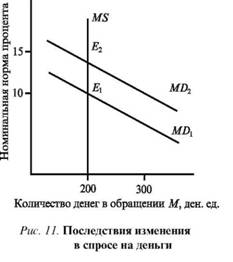home
 Banking Banking
 books books
 Money and credit - Ivanov VM Money and credit - Ivanov VM
|
Money and credit - Ivanov VM
7.4. The establishment of equilibrium and the effects of changes in supply and demand
Equilibrium in the money market takes place at the intersection of supply and demand curves. Equilibrium in the money market means equal amount of money that the economic agents want to keep in their portfolios of assets, the amount of money proposed by the NBU in the implementation of the current monetary policy.
Fig. 9 illustrates the interaction of supply and demand in the financial market and determines the position of equilibrium with respect to the money supply in circulation, and the nominal rate of interest. The vertical supply curve of money suggests that the government (NBU) has taken all necessary measures to maintain a constant state of money at 200 den. u regardless of changes in the nominal rate of interest. The graph shows that the people will be at the hands of precisely 200 den. u only at an interest rate equal to 10. At a lower rate of interest people will try to increase the amount of money in their portfolios, thereby pushing the prices of securities down, and the rate of interest - up, thereby achieving equilibrium. With higher interest rates people will strive to reduce the amount of money in their portfolios by buying securities, thus pushing prices up securities, and the rate of interest - down again, trying to achieve a balance. Thus, no other rate of interest in these circumstances can not create a balance in supply and demand in the money market.
Fig. 10 shows the effects of changes in money supply. Initially, the money market is in equilibrium at E1 M = 250 den. u and the rate of interest equal to 8. As the number

money in circulation to 160 den. u the supply curve will shift from MS1 to MS2. As a result of the depletion of the reserves of the banking system, banks are not able to provide the supply of money in the initial amount equal to 250 den. u at a rate of 8 percent.
To avoid the coming shortage of reserves banks are required to align their balance sheets. Some of them will increase the reserves by selling securities held by them, thus lowering the market price. Other banks may increase their reserves by withdrawing loans demand. Such events are tightening credit conditions on the loans market and contribute to the growth of interest rates. In addition, some banks may try to increase its reserves by taking loans from other banks. However, in total for the entire banking system is the lack of reserves will push up interest rates in the commission of such operations. Therefore, the banking system reaction to a reduction in reserves would lead to an increase in interest rates on all credit markets without exception.
As interest rates increase the economic agents will in turn adapt to new conditions.
Faced with an increase in the opportunity cost of holding money, they will exchange money for other assets, bringing more high income. Such changes correspond to the motion upwards to the left along the money demand curve. When the nominal interest rate reaches 12.5%, the amount of money that ultimately the economic agents prefer to store, to coincide with the amount of money offered by the banking system. Thus, the economic system reaches a new equilibrium at E2. Increasing the supply of money directs the processes discussed in the opposite direction. Held by the National Bank purchase securities in the money supply shifts the curve. Trying

maximum use of the newly received reserves, banks are starting to buy securities and easier credit conditions. Reduced interest rates, which increases the amount of money in the portfolio of assets of firms and households. Thus, the money market is moving to the right and down the curve of demand for money to a new equilibrium position.
Let us assume (Fig. 11), that certain circumstances (for example, an increase in the nominal national income) increase the amount of money demand from MD1 to MD2. This will lead to the fact that at an initial rate of interest equal to 10, people will want to keep more money in their portfolios of assets (300 den. Units) despite the fact that the banking system is able to offer only 200 den. u Therefore, an attempt to acquire more money by selling securities and requesting loans. These actions lead to an increase in the nominal rate of interest of up to 15, that ensures that the quantity of money in circulation (200 den. Units.), The amount of money held in the portfolios of assets of economic agents, in full accordance with their wishes. money market reaches a new equilibrium position (E2 point).
Reducing the demand for money is launching the review process at the opposite side. Assume that the demand curve shifted to the left down to the MD2 MD1 from the original equilibrium position E2. In this case, the share of money in the portfolio of assets of economic agents would be higher than it would coincide with their desires. So they begin to structural changes in their portfolios of assets or use money to pay off the loans taken earlier. Such actions drive up the price of securities and lower loan interest rate, but will not change the number of

money in circulation, which offers economic agents of the banking system. Equilibrium in the money market can be achieved only if the interest rates drop to a level that ensures compliance with the quantity of money in circulation, the amount of money placed in the portfolios of economic agents of assets.


Comments
Commenting, keep in mind that the content and the tone of your messages can hurt the feelings of real people, show respect and tolerance to his interlocutors, even if you do not share their opinion, your behavior in terms of freedom of speech and anonymity offered by the Internet, is changing not only virtual, but real world. All comments are hidden from the index, spam control.